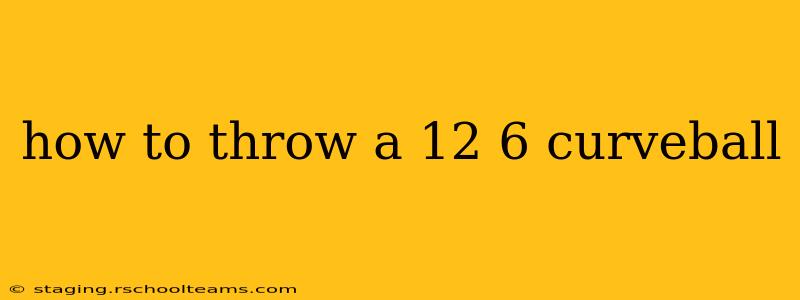How to Throw a 12-6 Curveball: A Comprehensive Guide
The 12-6 curveball, renowned for its sharp, dramatic break, is a coveted pitch in baseball. Mastering this pitch requires dedication, proper technique, and patience. This guide breaks down the mechanics, offering a step-by-step approach to help you develop your own devastating 12-6.
Understanding the 12-6 Curveball
The "12-6" refers to the direction of the break. Imagine a clock face on the catcher's mitt; a 12-6 curveball breaks sharply downward (6 o'clock) from its release point (12 o'clock). This dramatic drop is what makes it so effective, causing hitters to swing under the ball or completely miss. Unlike other curveballs which may have some lateral movement, the 12-6 primarily features a vertical break.
What grip should I use for a 12-6 curveball?
The grip is crucial for the 12-6 curveball's distinctive break. Most pitchers use a four-seam grip where the index and middle fingers are positioned along the seams on the top of the baseball, with the thumb underneath. The key here is to use the index and middle fingers to apply firm pressure, creating a spin axis that generates the significant downward movement. Experiment with slightly adjusting the position of your fingers across the seams; fine-tuning this aspect will be crucial to your individual curveball. Some pitchers find that a slight adjustment, even a few millimeters, makes a big difference in the ball's movement.
How much arm speed do I need to throw a good 12-6 curveball?
You don't need overpowering arm speed to throw an effective 12-6 curveball. While velocity helps, it's the grip and wrist snap that are more critical. Focus on developing the proper mechanics and wrist action to generate the desired spin. A slower, well-executed 12-6 with significant drop can be just as effective, if not more effective than a faster, less-defined curveball.
What is the best arm slot for a 12-6 curveball?
The optimal arm slot can vary based on individual pitcher's mechanics, but a three-quarters arm slot is generally recommended for the 12-6 curveball. This allows for a good combination of power and control while facilitating the necessary wrist snap. Experimenting with slight adjustments in your arm slot might help you find the best release point for your unique throwing motion.
How do I develop the proper wrist snap for a 12-6 curveball?
The wrist snap is the key to generating the 12-6's downward break. As you bring your arm forward in your throwing motion, you need to make a pronounced pronation, or rolling of your wrist. This action imparts the specific spin that creates the significant downward break. This action is the difference between a curveball that barely moves and one that drops dramatically. Practice this wrist snap without the ball to develop a feel for the movement.
How do I control my 12-6 curveball?
Control is essential for any pitch, especially one as unique as the 12-6 curveball. Consistent grip, a repeatable throwing motion, and proper practice are crucial for control. Start with shorter distances to develop a feel for the pitch before increasing the distance. Pay close attention to your body mechanics. Inconsistencies in your throwing motion will often lead to inconsistencies in your curveball.
How much arm strength do I need?
While increased arm strength can certainly aid in velocity, it's not the deciding factor for throwing an effective 12-6. The grip and wrist snap are considerably more important. The key is creating a strong spin, not necessarily a fast pitch. Many successful 12-6 curveball pitchers don't throw exceptionally hard.
Practice Makes Perfect
Developing a consistent 12-6 curveball takes time and dedication. Start with long toss, focusing on the wrist snap and grip. Then, progress to throwing from shorter distances, gradually increasing the distance as you become more comfortable. Work with a coach or experienced player for feedback and adjustments to your technique. Consistent practice will refine your form and enhance control. Remember that subtle changes in your grip and wrist can have a significant impact on the curveball’s movement, so experiment to find what works best for you. Patience and persistence are key to mastering this challenging but highly rewarding pitch.
